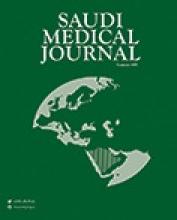Abstract
OBJECTIVE: To test the effect of sex steroids on the development of osteoporosis in male Saudi Arabs above the age of 50 years.
METHODS: Male Saudi patients over the age of 50 years, attending the outpatient clinics between May 2005 and January 2006 of King Fahd Hospital of the University, Al-Khobar, Kingdom of Saudi Arabia, comprised the study subjects. Patient's body mass index was calculated, and investigations were performed to rule out secondary osteoporosis. Blood was extracted for serum level of androgens, gonadotropins, and thyroid stimulating hormone, albumin, calcium, phosphorus, and alkaline phosphatase. Bone mineral density measurement of hip and spine was carried out using dual energy x-ray absorptiometry. Osteopenia and osteoporosis were defined per the World Health Organization description.
RESULTS: We analyzed the data of 181 patients with an average age of 61.76±0.75. Ninety-nine (54.7%) were osteopenic (Group B) and 54 (29.8%) were osteoporotic (Group C). Osteoporotic patients (Group C) had a higher testosterone level, 486.85ng/dl±17.18 versus 424.84ng/dl±20.93; p=0.001, and lower estradiol levels, 22.3pg/ml±0.73 versus 28.55pg/ml±1.82, p=0.001, compared to the non-osteoporotic patients (Group A). Compared to the non-osteoporotic group, the osteopenic patients had higher levels of testosterone (p=0.05) and lower estradiol levels (p=0.001).
CONCLUSION: Our study indicates that serum levels of testosterone in Saudi Arabian males of over 50 years have little influence on the protection against the development of osteoporosis and osteopenia, and secondly males who have a low level of estradiol are more likely to have low bone mineral density, osteopenia, or osteoporosis.
- Copyright: © Saudi Medical Journal
This is an open-access article distributed under the terms of the Creative Commons Attribution-Noncommercial-Share Alike 3.0 Unported, which permits unrestricted use, distribution, and reproduction in any medium, provided the original work is properly cited.






